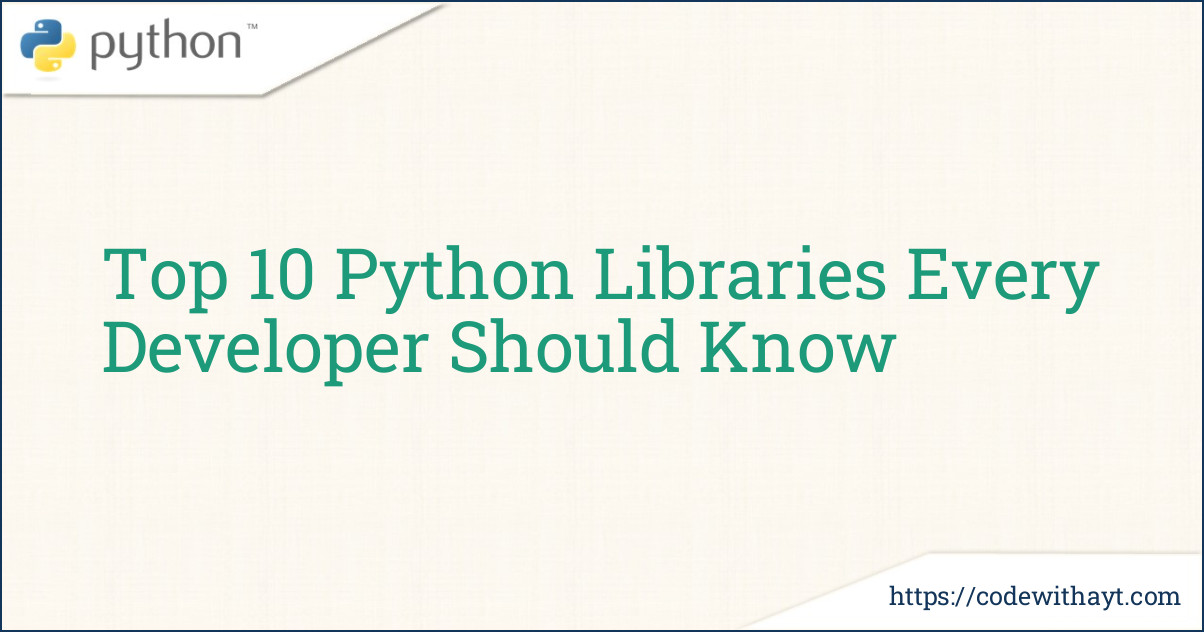Python is loved by beginners and pros alike for its clean syntax, flexibility, and most importantly—powerful libraries that do the heavy lifting in your code. Whether you're building a website, analyzing data, or training a machine learning model, Python has a library to make the job easier.
In this blog post, we’ll explore the top 10 Python libraries, explain what they do in plain English, and share helpful example links so you can try them out right away.
1. NumPy – For Fast Numerical Computing
What it does:
NumPy lets you handle large arrays and matrices of numerical data efficiently. It supports a variety of mathematical operations like linear algebra, statistics, and more.
Why it's useful:
If you're doing anything math-heavy or building data models, NumPy is a must.
Example:
import numpy as np
a = np.array([1, 2, 3])
print(a * 2) # Output: [2 4 6]
2. Pandas – For Data Analysis & Manipulation
What it does:
Pandas makes it super easy to load, clean, analyze, and visualize tabular data. It’s widely used in data science and finance.
Why it's useful:
It allows you to work with structured data quickly, like CSV files, Excel spreadsheets, or SQL databases.
Example:
import pandas as pd
df = pd.read_csv("sales.csv")
print(df.head())
3. Matplotlib – For Data Visualization
What it does:
Matplotlib helps you create visualizations like bar charts, line graphs, and scatter plots to better understand your data.
Why it's useful:
Graphs often tell a clearer story than raw numbers.
Example:
import matplotlib.pyplot as plt
x = [1, 2, 3, 4]
y = [10, 20, 25, 30]
plt.plot(x, y)
plt.title("Simple Line Plot")
plt.show()
4. Scikit-learn – For Machine Learning
What it does:
This library offers simple tools for data mining and building machine learning models like classification, regression, clustering, etc.
Why it's useful:
It’s great for building AI-powered apps without deep knowledge of math.
Example:
from sklearn.datasets import load_iris
from sklearn.tree import DecisionTreeClassifier
iris = load_iris()
model = DecisionTreeClassifier()
model.fit(iris.data, iris.target)
5. TensorFlow – For Deep Learning
What it does:
TensorFlow (developed by Google) is for building and training neural networks and deep learning models.
Why it's useful:
It powers real-world applications like voice recognition, image classification, and recommendation engines.
Example:
import tensorflow as tf
model = tf.keras.Sequential([
tf.keras.layers.Dense(10, activation='relu'),
tf.keras.layers.Dense(1)
])
6. Django – For Full-Stack Web Development
What it does:
Django is a web framework that lets you build secure, scalable websites with built-in features like authentication, database handling, and admin dashboards.
Why it's useful:
You can build complex web apps in just a few days.
Example:
django-admin startproject mysite
7. Flask – For Lightweight Web Apps and APIs
What it does:
Flask is a micro-framework for building simple web applications and REST APIs.
Why it's useful:
It’s easy to learn and flexible—perfect for small apps or APIs.
Example:
from flask import Flask
app = Flask(__name__)
@app.route("/")
def home():
return "Hello, Flask!"
app.run()
8. BeautifulSoup – For Web Scraping
What it does:
BeautifulSoup helps you extract data from HTML and XML web pages. It’s often used in web scraping projects.
Why it's useful:
You can collect data from websites even if they don’t have an API.
Example:
from bs4 import BeautifulSoup
import requests
url = 'https://example.com'
response = requests.get(url)
soup = BeautifulSoup(response.text, 'html.parser')
print(soup.title.string)
9. Requests – For Working with APIs
What it does:
Requests is a library that simplifies sending HTTP requests. Think of it as your tool for talking to APIs.
Why it's useful:
It’s way easier than using Python’s built-in HTTP modules.
Example:
import requests
response = requests.get('https://api.github.com')
print(response.json())
10. OpenCV – For Computer Vision
What it does:
OpenCV allows you to process images and videos. It supports facial recognition, motion tracking, and more.
Why it's useful:
If you're working with cameras, security, or AR apps—this is the go-to tool.
Example:
import cv2
img = cv2.imread('photo.jpg')
cv2.imshow('Image', img)
cv2.waitKey(0)
cv2.destroyAllWindows()
Final Thoughts
Python is already a powerful language, but with these 10 libraries, you can take your coding to the next level. Whether you’re interested in data science, web apps, AI, or automation, these libraries cover it all.
Quick Recap:
| Library | Best For |
|---|---|
| NumPy | Math, Arrays |
| Pandas | Data manipulation |
| Matplotlib | Data visualization |
| Scikit-learn | Machine learning |
| TensorFlow | Deep learning |
| Django | Full-stack web development |
| Flask | APIs and lightweight apps |
| BeautifulSoup | Web scraping |
| Requests | HTTP requests, APIs |
| OpenCV | Image and video processing |



